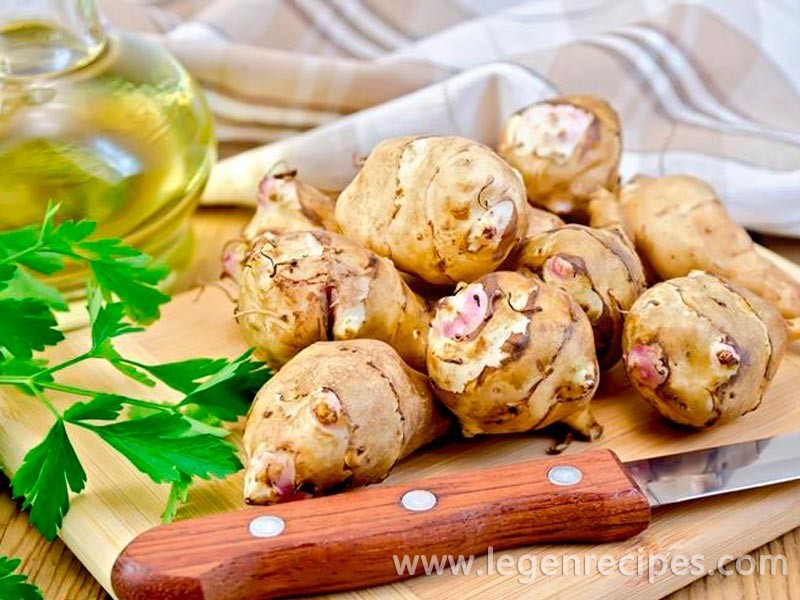Jerusalem artichoke.
The name of the root – “Jerusalem artichoke” – comes from the South American Indian tribe – tupinambo. The Indians cultivated artichokes long before America poured troops conquistadors. The first of the European countries with this vegetable in 1610 met the British and then the French, which was given its current name of root crops.
Taste of Jerusalem artichoke nutty, a bit like a chestnut, the structure – like a radish. Clean it easy: a knife cut off the top layer is quite thick, so it is best to clean off the rind with a knife, a housekeeper, as well as we clean new potatoes or root pre blanch in a pan.
Jerusalem artichoke – a very useful root vegetable. As there are a lot of vitamins and minerals (potassium, zinc, iron, silica), and, moreover, in the tubers contain vegetable insulin analogue – polysaccharide inulin (with a lot of up to 17%) that is very useful for people suffering from diabetes, he reduces blood sugar level. In addition, the Jerusalem artichoke helps in atherosclerosis, hypertension, poor eyesight, cystitis, tuberculosis, leukemia, anemia, obesity.
Until recently, buy artichoke in Russia was very difficult, he occasionally appeared on the shelves of Moscow’s markets. Now Sweet and sold in markets and large supermarkets, but in the past it is quite expensive.
The types and grades
In the world there are more than 300 varieties and hybrids of Jerusalem artichoke. Some are distinguished by a large tubers, others – green mass (at small tubers), and others – a special decorative, fourth – early ripening season and so on. Industry in Russia are grown mainly two varieties of Jerusalem artichoke: Skorospelka ripen in September and November – interest.
In culinary terms are different varieties of Jerusalem artichoke is not much different from each other.
By crossing Jerusalem artichoke with sunflower Russian breeders in the 1940s created a new plant – topinsolnechnik. Tubers from this variety are large, oval, smooth, and the harvest is very large; however, their use, mostly as a feed product.
How to cook
Jerusalem artichokes can be eaten raw, rubbed it in a salad, you can make it a soup or sauce for garnish.
One of the traditional recipe invented by the British: they clean the fruit, cut into quarters, blanch half an hour stew, covered in butter, add the cream (or bechamel sauce), tantalized another ten minutes and serve, sprinkled with tarragon and chervil, as a side dish (often all veal). Topinamber and boiled in wine, especially in France and the Netherlands. There are other fine options for use of artichoke, such as multi-layer casserole with foie gras and truffles.
Season
Most early varieties of artichoke crop yield in September, later – in November. Jerusalem artichoke well preserved under the snow, so the crop is removed in the spring, in March-April.
How to choose and store
When choosing a Jerusalem artichoke in the shops in the first place should pay attention to his skin. If you take in hand the tuber and feel that it is soft and sluggish, so it does not suit you. If the skin has a wrinkled appearance and her show through the stain, then the fruit of poor quality.
If the surface you will find all sorts of artichoke roughness and nodules, it is quite normal.
With long-term storage of tubers of Jerusalem artichoke, things are much worse than with potatoes and beetroot, which in the right conditions to successfully lie until the new harvest. Jerusalem artichoke is stored in the cellar for about a month. Then he fades or starts to rot. The problem is that the skin is very thin and tubers devoid cork layer, however can not withstand drying and easily damaged. The longer you can keep the tubers, interspersing them with a damp earth or sand, but this event is already greatly complicates matters.
A small amount of Jerusalem artichoke can be for several weeks stored in a refrigerator and the freezer, even better in edible paper bag.




